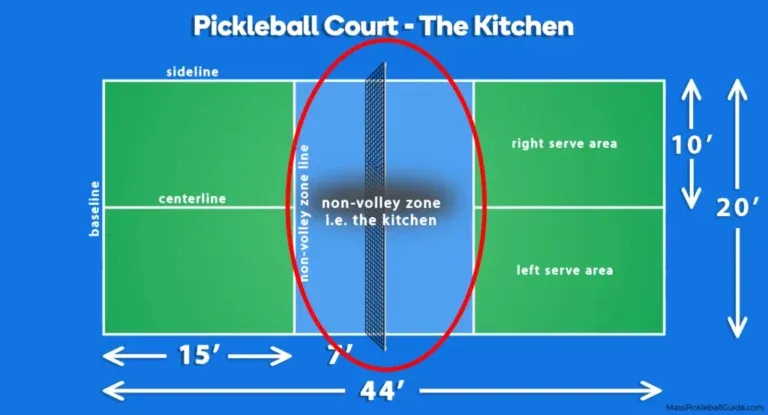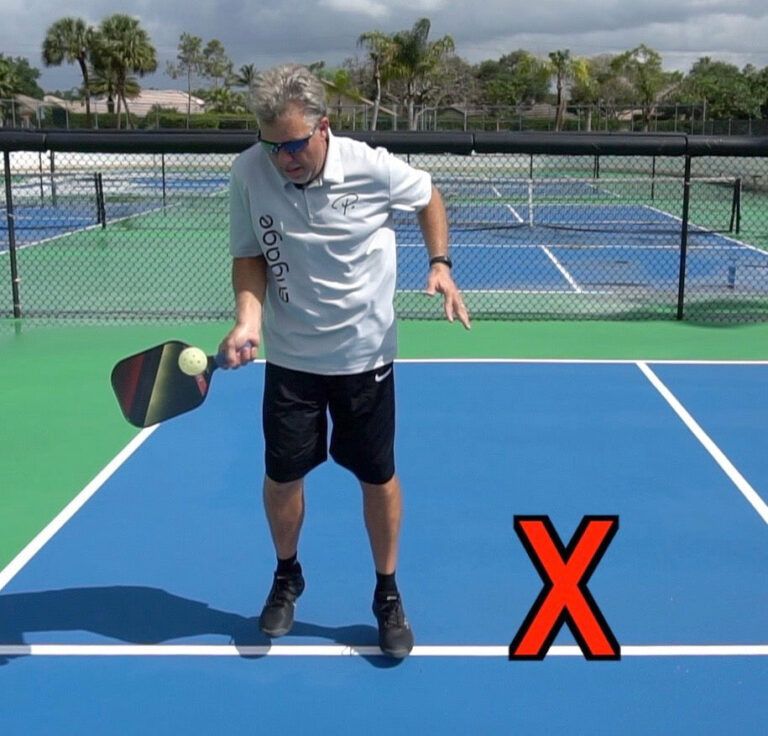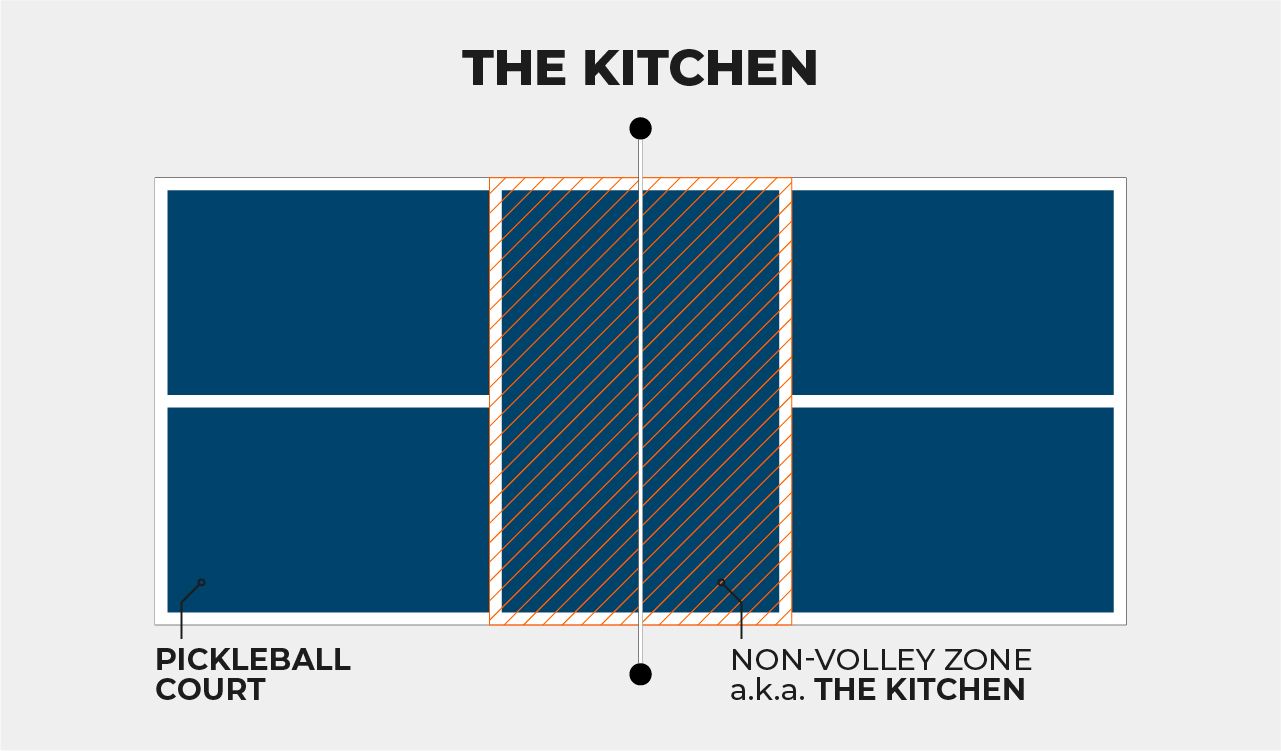Understanding the pickleball kitchen (NVZ)
The kitchen, also known as the non-volley zone (NVZ), holds a significant place in the game of pickleball. This area spreads out for seven feet deep on either side of the net and extends from sideline to sideline. It serves both as a physical zone and a mental barrier for players. Understanding its dimensions and purpose is crucial for beginners and seasoned players alike.

The kitchen plays a vital role in establishing the rules of engagement near the net. Players are prohibited from volleying the ball while standing within this zone, meaning they must allow the ball to bounce before attempting a return. This rule encourages more strategic play, pushing players to develop their skills around the techniques of returning shots, preventing simple overhead smashes and supporting cunning dinks instead.
Kitchen dimensions:
- Depth: 7 feet on each side of the net
- Width: Spans from sideline to sideline
- Purpose: Prevents volleying, encourages strategic play
Adding a diagram of a pickleball court highlighting the kitchen area can visually reinforce this crucial location on the court. This unique aspect creates an environment where players are urged to utilize tactics such as dinking while remaining mindful of their positioning and movement.
The purpose of the kitchen rule
The kitchen rule is much more than just a quirky term; it directly influences gameplay strategy and dynamics. By enforcing a no-volleying policy in this critical zone, the kitchen helps to level the playing field between players of different skill levels, emphasizing the importance of clever play rather than raw power.
This rule encourages players to engage in a game of finesse, rather than one of brute strength, bringing a new layer of sophistication to the sport. Practicing dink shots becomes vital as players must focus on maintaining a strategic position while maneuvering the ball safely in and around the kitchen. Thus, the kitchen fosters a more balanced playing experience, discouraging aggressive, power-focused shots that could dominate the game.
Key benefits of the kitchen rule:
- Encourages strategy: Without the ability to volley, players must rely on technique and placement.
- Promotes skill development: Focus on dinking and control over raw power allows for skill acquisition.
- Enhances game balance: The rule helps less experienced players compete more effectively against opponents with stronger shots.
The kitchen transforms how players approach the game, requiring them to think long-term about positioning and shot selection. The balance it brings can be compared to a tightrope walk players must navigate carefully while balancing risks against rewards.
Unpacking the theories: Why is it called kitchen in pickleball?
The term "kitchen" has sparked multiple theories regarding its quirky nomenclature. Each theory offers a unique insight into how this playful term came to shape the gameplay in pickleball. As we dive into these theories, we uncover elements of cultural connection and historical anecdotes that enrich the sport's legacy.
The shuffleboard connection
One of the most talked-about theories connects the non-volley zone in pickleball to a similar area in shuffleboard, often called the "10-off" zone. In shuffleboard, if a player's disc lands in this area, they lose points, much like players who fail to keep their feet out of the kitchen while attempting to volley. This connection emphasizes the strategic maneuvering required in both games, suggesting that both sports share a conceptual framework around risk management and point penalties.
- Similarities between pickleball and shuffleboard:
- Strategic positioning: Both sports encourage players to think critically about their placement.
- Penalties for risky shots: Landing in problematic zones can lead to penalties.
This comparison elucidates how the kitchen in pickleball maintains similar stakes, creating a competitive atmosphere that requires precision and focus, mirroring the strategic layers found in shuffleboard.
Other theories and anecdotes
While the shuffleboard theory carries significant weight, other ideas contribute to the colorful lore surrounding the term "kitchen." A popular anecdote relates to the saying, "If you can't handle the heat, get out of the kitchen." This saying implies that players in the kitchen zone must navigate skillfully and cope with the pressures of close-range play. A related theory, often called the "soup's on" theory, suggests that the kitchen represents an area where mistakes can easily lead to defeat, reminiscent of spoiling a perfect meal.
In addition to these theories, the "three dads theory" adds an element of humor and casualness to the sport's history. The founders of pickleball, three fathers Joel Pritchard, Bill Bell, and Barney McCallum were known for their playful and informal approach to naming different aspects of the game. This theory posits that the word "kitchen" emerged simply from their whimsical creativity, reflecting a lighthearted moment in the sport’s early days.
The mystery remains...
Despite the significance of these theories, the true origin of the term "kitchen" in pickleball may never be fully clarified. The ambiguity surrounding its context adds to the allure of the sport and allows players to craft their own interpretations based on personal experiences and identities. Whether the name stems from a deliberate connection to shuffleboard, a famous saying, or casual naming conventions, it remains an engaging part of pickleball culture.
Mastering the kitchen: rules and strategies
Mastering the kitchen is integral for any pickleball player looking to elevate their game. Understanding the specific rules associated with this crucial area opens up numerous strategic avenues, allowing players to employ diverse tactics effectively. By focusing on these regulations and honing their skills in the kitchen, players can build a solid foundation for success.

The no-volley zone: volleying restrictions
One of the key rules surrounding the kitchen is the no-volleying principle, which prohibits players from hitting the ball out of the air while standing in this zone. For example, if a player steps into the kitchen while attempting to volley the ball, it results in a fault. This regulation encourages careful positioning and movement on the court.
- No-volleying rule:
- Standing in the kitchen: Prohibited from hitting the ball before it bounces.
- Key takeaway: Precision in movement and timing is essential.
Understanding and respecting this rule helps players develop better control over the ball, especially during intense rallies that require split-second decisions.
Avoiding foot faults
Now that we've established the importance of the no-volleying rule, it’s essential to highlight the concept of foot faults. A foot fault occurs when a player steps into the kitchen during a volley or allows their momentum to carry them in. This common oversight may lead to unnecessary loss of points and disrupt gameplay.
- Foot fault tips:
- Stay alert: Be mindful of foot positioning to avoid violations.
- Practice footwork: Develop agility and movement to control your movement around the kitchen.
By focusing on foot placement and anticipating movement, players can effectively sidestep mistakes and maximize the opportunities that arise during kitchen play.
Other kitchen rules
There are additional rules surrounding the kitchen that players should be aware of to navigate this area effectively. For instance, if a player drops an item within the kitchen, it may lead to disputes or confusion. Furthermore, players must also be cautious when returning balls that bounce in the kitchen, ensuring that they follow the no-volleying protocol while attempting to make effective shots.
- Drop item regulations: Avoid dropping personal items in the kitchen area.
- Bouncing ball strategies: Understand the tactical options when dealing with balls landing in the kitchen.
These rules help maintain the integrity of gameplay while ensuring that players focus on honing their skills in the kitchen.
Strategic play in the kitchen
To truly master the kitchen, players must employ effective strategies that focus on creating plays that capitalize on the unique dynamics of this zone. Emphasizing the importance of dinking, positioning, and shot returns can dramatically impact overall performance and effectiveness.

- Dinking:
- Maintain control while keeping the ball low.
- Set up opportunities for aggressive shots by forcing opponents to play defensively.
- Positioning:
- Identify strong positioning by remaining close to the kitchen line.
- Utilize body language and anticipation skills to counter opponents effectively.
- Returning shots:
- Analyze the approach of opponents and adapt quickly.
- Work on angles and placement when returning shots to keep adversaries off balance.
By analyzing and implementing these strategies, players can gain a competitive edge, cultivating a deeper understanding of the game's nuances in and around the kitchen.
The mental game: winning in the kitchen
Beyond the physicality of plays in the kitchen lies a crucial mental component that shapes the success of pickleball players. Managing the psychological aspects of close-quarters engagement plays a significant role in achieving victory in the kitchen. Developing a strong mental framework ultimately contributes to performance consistency.
Staying calm under pressure
Staying calm during tense moments near the kitchen can prove challenging yet essential for maintaining composure. Players must balance quick decision-making with strategic planning while contending with the high-pressure environment established within this small confines area. Employing breathing techniques, visualization, and focusing on footwork can nurture a sense of control during intense rallies.
Reading your opponent
Understanding your opponent's movements based on their positioning and body language can provide valuable insight into their playing style. Observing their foot placement, swing dynamics, and decision-making patterns creates an opportunity for players to anticipate their next moves, allowing for effective counterplay. This encourages smart tactical decisions tailored to exploit weaknesses.
Developing kitchen confidence
Building confidence in kitchen skills enhances overall performance. Players can cultivate their confidence through consistent practice, seeking feedback from experienced players, and engaging in recreational play to hone their skills without high-stakes pressure. Confidence in the kitchen often translates into improved decision-making and responding to opponents' moves effectively.
Beyond the basics: advanced kitchen play
As players become more comfortable in the kitchen, they may seek to expand their repertoire of techniques and advanced play. Mastering sophisticated tactics equips players to outmaneuver their opponents and dominate the kitchen.
Attacking with the erne
The erne is an aggressive tactic that involves a player anticipating a high ball at the net. When executed properly, the erne allows players to strategically attack those high volleys without stepping foot into the kitchen. Mastering this skill demands precise timing and expertly coordinated footwork, fostering a unique advantage against less prepared opponents.
Utilizing the soft game
Employing finesse and touch during kitchen play represents a key dimension of advanced tactics. Developing the ability to execute softer shots and manage their trajectory can create advantageous situations for players. By controlling the speed and path of their shots, players can force opponents into awkward positions, thus dictating the flow of gameplay.
Drop shot mastery
Developing effective drop shots can disrupt opponents while keeping them guessing. This advanced technique requires an understanding of timing and accuracy, lending itself to setting up future shots. Dropping the ball skillfully just over the net or within the kitchen can yield significant rewards while maintaining control of the play.
Kitchen play in different pickleball formats
Pickleball offers various formats for players to explore and modify their kitchen strategies. Whether participating in singles, doubles, or adaptive pickleball, unique challenges and adaptations arise.
Singles strategies
In singles play, kitchen dynamics shift considerably, pushing players to adapt their approaches. The lack of a partner can heighten pressure and intensify decision-making. Players may need to modify their expectations and develop solo strategies that leverage individual skill sets.
Doubles dynamics
Doubles play introduces a team aspect that changes how players interact within the kitchen. Effective communication and partner positioning become paramount as players strive to support each other during dynamic rallies. Establishing clear roles and responsibilities helps maintain flow and enhances the overall performance in this high-stakes area.
Adaptations in adaptive pickleball
Adaptive pickleball fosters inclusion and accessibility, incorporating modifications to accommodate players facing various challenges. Kitchen rules may be adapted to ensure fairness while allowing players to fully participate in the game. Understanding these adaptations encourages a spirit of understanding and camaraderie that coexists across the entire pickleball community.
In conclusion, the term "kitchen" in pickleball evokes creativity and strategy, embodying the enduring spirit of the game. While its true origins may remain a mystery, its significance in gameplay cannot be disputed. From the fascinating rules governing the non-volley zone to the deliberate strategies employed within it, the kitchen reveals a lot about pickleball as both a sport and a community. As players continue to navigate this enriching space, unlocking its many intricacies, they will undoubtedly experience countless moments of joy, camaraderie, and understanding along the way.










